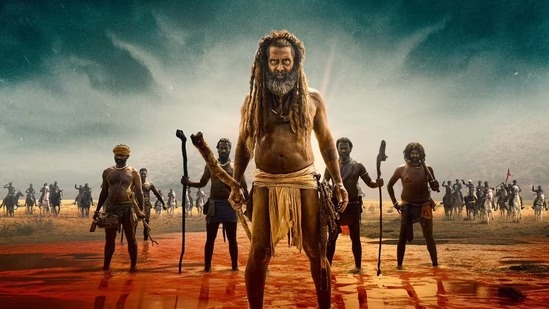The film is lauded for its rich visual storytelling and Vikram’s stellar performance. His portrayal of Thangalaan is powerful, seamlessly blending physical prowess with emotional depth, making the character’s journey compelling. Vikram’s ability to embody the complexities of Thangalaan, a leader torn between survival and rebellion, is one of the highlights of the film. The supporting cast, including Parvathy Thiruvothu and Malavika Mohanan, also deliver strong performances, with Mohanan’s character Aarathi adding a mystical dimension to the narrative. Pa Ranjith’s direction is praised for its ability to blend commercial cinema with art-house sensibilities. The film’s cinematography by A. Kishor Kumar captures the rugged beauty of the Kolar Gold Fields, while GV Prakash Kumar’s folk-inspired score enriches the film’s atmosphere. The slow pacing, particularly in dialogue-heavy scenes, and the subpar visual effects have been points of criticism. Additionally, the decision to use a unique Tamil dialect and sync sound dubbing has been noted as a barrier for some audiences. Despite these shortcomings, Thangalaan is a powerful film that resonates with its themes of oppression and reclamation. The narrative explores the struggles of the oppressed, not just against external forces but within their own communities, making it a nuanced tale of resistance and identity. The film’s engagem ent with historical and mythical elements adds depth to its portrayal of power dynamics and the fight for what is rightfully theirs. Overall, Thangalaan is a compelling watch, especially for those interested in films that blend historical narratives with strong political undercurrents, all while being anchored by a mesmerizing performance from Vikram . “Thangalaan”, directed by Pa Ranjith, is a historical drama that masterfully intertwines fantasy and mystical realism, presenting a story rich in cultural and political undertones. Set in the 19th century in the Kolar Gold Fields (KGF) during the British Raj, the film stars Vikram in the titular role, showcasing one of his most compelling performances to date. The narrative delves deep into the lives of a tribal community led by Thangalaan, exploring themes of identity, power, and reclamation amidst the backdrop of colonial exploitation.
Thangalaan review: Vikram delivers a spellbinding performance in this Pa Ranjith film
The story of “Thangalaan” is rooted in the socio-political landscape of the 1850s, a time when the British Empire was expanding its influence across India. The film is set in the Veppur village of North Arcot, where the British have discovered traces of gold. Thangalaan (played by Vikram) is the tribal leader whose people are caught in the crossfire between their ancestral land and the colonial powers that seek to exploit it. The British, represented by Lord Clement (Daniel Caltagirone), enlist the tribals to mine the gold, but the discovery comes with a curse—the wrath of Aarathi (Malavika Mohanan), a local sorceress who embodies the mystical forces protecting the land. Pa Ranjith has been known for his films that address the struggles of the oppressed, often focusing on Dalit issues and caste-based discrimination. In “Thangalaan”, he brings these themes into the historical context of colonial India, highlighting the exploitation of tribal communities by the British. The film’s narrative structure is non-linear, weaving between the harsh realities of the colonial era and the fantastical elements introduced by the character of Aarathi. This blend of history and fantasy allows Ranjith to explore not just the physical, but also the spiritual and psychological impact of colonization on the tribal people. Vikram’s portrayal of Thangalaan is nothing short of mesmerizing. Known for his ability to transform into diverse characters, Vikram brings a raw intensity to the role, embodying the strength and vulnerability of a leader who is deeply connected to his land and people. Thangalaan is a character torn between his duty to protect his tribe and the overwhelming forces of colonial power. Vikram’s performance captures this internal conflict, making the character both heroic and tragic. One of the most striking aspects of Vikram’s performance is his physicality. Thangalaan is depicted as a warrior, and Vikram’s dedication to the role is evident in his transformation into this rugged, formidable leader. His interactions with the other characters, particularly his wife Gangamma (played by Parvathy Thiruvothu), add layers of emotional depth to the story. The chemistry between Vikram and Parvathy is palpable, and their scenes together provide some of the film’s most poignant moments. Vikram’s portrayal is not just about physical strength; it is also about conveying the psychological burden of leadership. Thangalaan’s journey is one of self-discovery as much as it is a fight for survival. This duality is what makes Vikram’s performance so compelling—he is not just a leader fighting external enemies but a man grappling with his own fears, doubts, and responsibilities. Pa Ranjith’s directorial style in “Thangalaan” is a blend of commercial and art-house cinema. He employs a unique visual language that is both grounded in the realism of the time period and elevated by elements of magic realism. The film’s visual aesthetic is gritty and immersive, capturing the harsh, dusty landscape of the Kolar Gold Fields while also creating a sense of otherworldliness through the use of mystical symbols and motifs. One of the key strengths of Ranjith’s direction is his ability to humanize the characters, making them more than just representations of good and evil. This is particularly evident in his portrayal of the antagonist, Lord Clement. Rather than depicting him as a one-dimensional villain, Ranjith gives Clement a backstory and a sense of purpose that makes him a more complex character. This complexity extends to the depiction of the tribal community itself, which is shown not just as victims of colonialism but as a society with its own internal conflicts and hierarchies.
